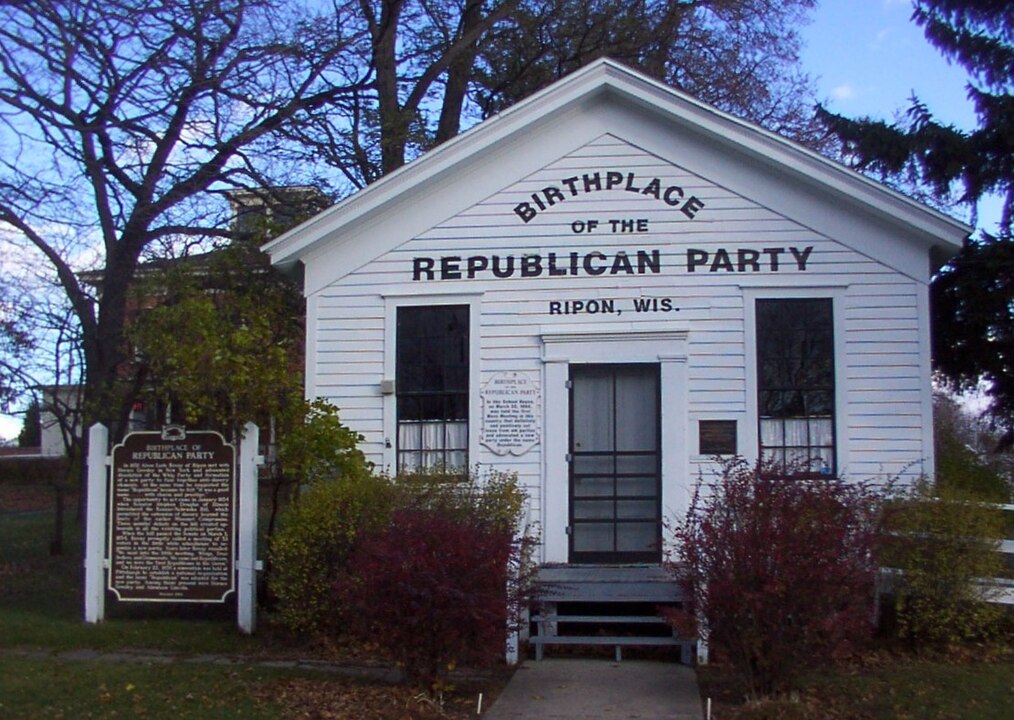Fusion politics, two groups of citizens supporting a common candidate on the ballot, has a long and colorful history in the United States. This was particularly true in Midwestern states like Wisconsin. Fusion politics allowed Wisconsin voters not happy with either major party to form new party groups that worked tirelessly and successfully to shape the policies of the major parties on important issues. In fact, in the early years of our statehood fusion politics led to the creation of a new anti-slavery party — the Republicans — which went on to dominate Wisconsin politics for the next 70 years.
During the last half of the 19th century, minor party movements in Wisconsin enjoyed the freedom to organize, express their views, and influence elections. As a result, a long list of parties used electoral fusion to advance the political interests of party members.
The most-successful third-party in American history was born in Ripon, Wisconsin, on March 20, 1854. Alan E. Bovay, a former member of the Whig Party, summarized the moment: “We went into the little meeting held in a schoolhouse Whigs, Free Soilers, and Democrats. We came out of it Republicans.” Three months later, over a thousand delegates attended the first Republican Party convention in Madison, Wisconsin, where they nominated candidates for Wisconsin’s three congressional seats. The district conventions “conveniently selected a Free Soiler, a Whig, and an Anti-Nebraska Democrat to run as Republicans,” and two of the three won. Republicans went on to become the dominant party in Wisconsin for the rest of the century, winning all but one presidential election and most gubernatorial and Senate races.

During this long period of Republican control, issues related to economic downturns, ethnic and religious discrimination, discontent with the power of big business and the railroads, and the cause of temperance helped power many third-party efforts in Wisconsin. Fusion between these various groups and fusion with the struggling Democratic party allowed voters to express discontent with both of the major parties in 1898.
In the early 1870s, a coalition of Northern Democrats, reform and liberal Republicans, Grangers, and anti-temperance groups joined together to form the Reform Party (also called the People’s Reform Party or Liberal Reform Party). William R. Taylor, campaigned for governor on issues such as railroad regulation, farmer representation, beer and alcohol and anti-corruption—all issues that helped draw Reform support. Electoral fusion between his Democratic party and the Reform Party led to his election in 1874 with 55% of the vote. The Reform Party also won seats in the US House and a majority in the state assembly.
Later, another minor party, the Greenback party, which was made up of Grangers, farmers, workers and small businessmen who promoted the use of paper money to ease their debts, fused with the Democrats and won enough seats in the state Assembly to elect the Assembly Speaker.

Anti-monopoly parties and the Knights of Labor (a precursor to the Labor party) also fused with Democrats. In Racine, a Labor stronghold, one newspaper noted this coalition had “the power to elect whom they please in the city.”
In 1889, Wisconsin adopted the use of an official state ballot printed and distributed at public expense. Minor parties, however, continued to appear on the ballot and could cross-nominate major party candidates. In the early 1890s, the “Panic of 1893,” an economic crash, spurred the growth of several parties, including Labor, the Socialist Party, and the Silver Party. Their respective leaders often sparred with each other and religious and ethnic differences frustrated some alliances, but in 1896 the Populists, Silver Party and Democrats backed a fusion ticket that included all the state’s top offices as well as William Jennings Bryan for President.
In 1897, frustrated by the constant threat of fusion, the Republican-dominated legislature passed a law preventing multiple party nominations. As we moved into the 20th century, minor parties no longer had the right to use fusion to express frustration with the policies of the major parties and to advance their own political goals and values.

¹William Starr Myers, The Republican Party: A History (Century, 1928), 44. In other states, the Know-Nothing party had already developed as a significant anti-Slavery movement, but the Know-Nothings were passionately anti-immigrant and achieved little success in immigrant-rich Wisconsin. (Fowler, Wisconsin Votes, 17). Nationally, the Know-Nothings fused with disaffected Whigs to nominate Millard Fillmore for President in 1856, who received 21% of the popular vote. The Know-Nothings then played a critical role by fusing with the emerging Republican Party to elect Abraham Lincoln in 1860.
²Brooks, Liberty Power, 196.